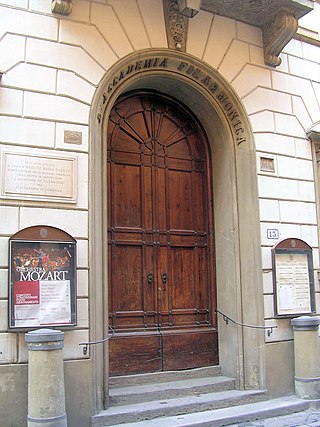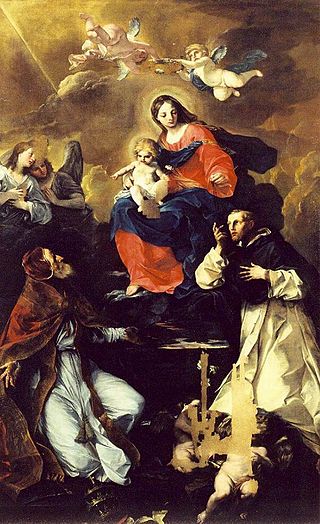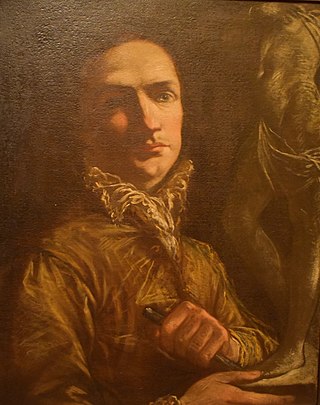
Carlo Cignani was an Italian painter. His innovative style referred to as his 'new manner' introduced a reflective, intimate mood of painting and presaged the later pictures of Guido Reni and Guercino, as well as those of Simone Cantarini. This gentle manner marked a break with the more energetic style of earlier Bolognese classicism of the Bolognese School of painting.

Giuseppe Maria Crespi, nicknamed Lo Spagnuolo, was an Italian late Baroque painter of the Bolognese School. His eclectic output includes religious paintings and portraits, but he is now most famous for his genre paintings.

The Bolognese School of painting, also known as the School of Bologna, flourished between the 16th and 17th centuries in Bologna, which rivalled Florence and Rome as the center of painting in Italy. Its most important representatives include the Carracci family, including Ludovico Carracci and his two cousins, the brothers Agostino and Annibale Carracci. Later, it included other Baroque painters: Domenichino and Lanfranco, active mostly in Rome, eventually Guercino and Guido Reni, and Accademia degli Incamminati in Bologna, which was run by Lodovico Carracci. Certain artistic conventions, which over time became traditionalist, had been developed in Rome during the first decades of the 16th century. As time passed, some artists sought new approaches to their work that no longer reflected only the Roman manner. The Carracci studio sought innovation or invention, seeking new ways to break away from traditional modes of painting while continuing to look for inspiration from their literary contemporaries; the studio formulated a style that was distinguished from the recognized manners of art in their time. This style was seen as both systematic and imitative, borrowing particular motifs from the past Roman schools of art and innovating a modernistic approach.

The Accademia Filarmonica di Bologna is a music education institution in Bologna, Italy.

The Archdiocese of Bologna is a Latin Church ecclesiastical territory or archdiocese of the Catholic Church in Northern Italy. The cathedra is in the cathedral church of San Pietro, Bologna. The current archbishop is Cardinal Matteo Zuppi, who was installed in 2015.

Domenico Maria Canuti was an Italian painter of the Baroque period, active mainly in Bologna and Rome. He was a major painter of fresco decorations. His ceiling decorations showed a mix of Bolognese and Roman influences.

The Galli–Bibiena family, or Galli da Bibiena, was a family of Italian artists of the 17th and 18th centuries, including:

Giovanni Gioseffo dal Sole was an Italian painter and engraver from Bologna, active in the late-Baroque period. Upon the death of Carlo Cignani, Gioseffo dal Sole became among the most prominent painters in Bologna, described as the Guido Moderno.

Felice Torelli was an Italian painter of the Baroque style, active mainly in Bologna.

Antonio Randa was an Italian painter of the classicist period, active in Ferrara, Modena, Rovigo, Florence, Comacchio and his native Bologna.
Antonio Dardani (1677–1735) was an Italian painter of the Baroque period, mainly in his native Bologna..
La passione di Gesù Cristo is a libretto by Pietro Metastasio which was repeatedly set as an azione sacra or oratorio by many composers of the late baroque, Rococo and early classical period.
Angelo Gabriello Piò was an Italian sculptor, active in Bologna in a Rococo style.

Giuseppe Maria Mazza was one of the leading sculptors of Bologna, Italy, in the late 17th and early 18th centuries. He was trained as a painter, but is best known for his fine sculptural work in terracotta and stucco.

Giuseppe Maria Mitelli (1634–1718) was an Italian engraver and painter of the Baroque period. He was the son of the prominent quadratura painter Agostino Mitelli. The younger Mitelli was best known for his prolific engravings, in a great variety of subjects, including scenes from grand epics to mundane page boards for games of chance using dice, Tarot cards, and an Iconophor with anthropomorphized alphabets. He also engraved genre subjects, allegories, moralistic scenes, but even some bizarre cartoons that could be interpreted as sometimes provocatively subversive, or presciently revolutionary, and sometimes imaginatively bizarre. He often depicted dwarfs engaged in buffoonery or satirical depictions of aphorisms, which recalls the Bambocciate di nani or arte pigmeo of genre painter Faustino Bocchi (1659–1742).
Pietro Scandellari (1711–1789) was an Italian painter and scenic designer.

San Paolo Maggiore, also known as San Paolo Decollato, is a Baroque-style, Roman Catholic basilica church located on Via Carbonari #18 in Bologna, region of Emilia-Romagna, Italy.
Antonio Rolli or Roli (1643–1695) is an Italian painter active painting quadrature during the Baroque period, mainly in his native Bologna.
Giuseppe Maria Rolli or Roli is an Italian painter and engraver active during the Baroque period, mainly in his native Bologna.
Varotti is a surname. Notable people with the surname include:













